Pholidophorus
| Pholidophorus | ||||||||||||
|---|---|---|---|---|---|---|---|---|---|---|---|---|

The type species Pholidophorus bechei from the Black Jura in the Urwelt Museum Hauff in Holzmaden . |
||||||||||||
| Temporal occurrence | ||||||||||||
| Upper Triassic to Jura | ||||||||||||
| Locations | ||||||||||||
|
||||||||||||
| Systematics | ||||||||||||
|
||||||||||||
| Scientific name | ||||||||||||
| Pholidophorus | ||||||||||||
| Agassiz , 1843 |
Pholidophorus is an extinct genus of bony fish . They lived from the Upper Triassic to the Jura . Fossils were u. a. found in Europe and North America. The genus was established in 1832 by the American naturalist Louis Agassiz fortwo Triassic fish species foundin Seefeld in Tyrol ( Pholidophorus latiusculus and Pholidophorus pusillus )
features
Louis Agassiz only gave general characteristics in his first description of the genus, such as a herring-like appearance, an elongated or spindle-shaped body, large rhombus-shaped scales, a caudal fins with two almost equally large lobes. The scales reached down to the upper lobe . The small dorsal fin was opposite the pelvic fins. The anal fin was very small. Later descriptions by Agassiz and other scientists only mentioned characteristics that are widespread among the Neopterygii and usually repeat the diagnostic characteristics of the order Pholidophoriformes and the family Pholidophoridae . Because of this imprecise diagnosis , various fish species from around the world, from the Upper Triassic to the Cretaceous, were assigned to the genus. The Swedish zoologist Orvar Nybelin finally limited the genus to four species that had a scaling after the species of Lepisosteus . The scales were diamond-shaped (rhomboidal) and slightly raised, as well as higher than long and had a smooth posterior margin and fine lines near the posterior margin. The belly scales were small, slightly oval and had one to three protrusions on the rear edge. The caudal fin was deeply forked. The eye sockets were relatively large, the jaws weakly dentate.
Species with different scales were assigned to other genera, e.g. B. Ankylophorus , Pholidophoroides and Pholidophoristion for species with scales of the Lepisosteus type but with an ornamented surface and strongly sawn rear edge , Eurycormus for species with scales of the Amia type and Pholidophoropsis for species with round scales .
species
Nybelin only recognized four species in its revision:
- Pholidophorus bechei
- Pholidophorus caffii
- Pholidophorus latiusculus
- Pholidophorus pusillus
Because of the inexact diagnosis of the genus, numerous other species from the Upper Triassic to the Cretaceous were assigned to the genus.
literature
- Gloria Arratia: New teleostean fishes from the Jurassic of southern Germany and the systematic problems concerning the 'pholidophoriforms'. , Paläontologische Zeitschrift, May 2000, Volume 74, Issue 1–2, Springer-Verlag, DOI: 10.1007 / BF02987957 , ISSN 0031-0220 (print) ISSN 1867-6812 (online)
- Toni Bürgin, Heinz Furrer: Fossil bony fish from the Kössen formation (Upper Triassic; Rhaet) from Lorüns (Vorarlberg, Austria). PDF
Web links
- The Paleobiology Database: Pholidophorus